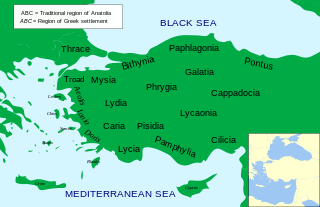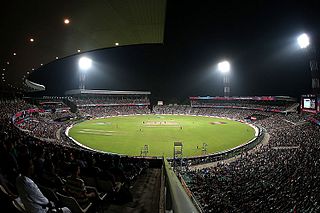
The Cricket World Cup is the international championship of One Day International (ODI) cricket. The event is organised by the sport's governing body, the International Cricket Council (ICC), every four years, with preliminary qualification rounds leading up to a finals tournament. The tournament is one of the world's most viewed sporting events and is considered the "flagship event of the international cricket calendar" by the ICC.

The International Cricket Council (ICC) is the world governing body of cricket. It was founded as the Imperial Cricket Conference in 1909 by representatives from Australia, England and South Africa. It was renamed as the International Cricket Conference in 1965, and took up its current name in 1987. The ICC has its headquarters in Dubai, UAE.
The India men's national cricket team, also known as Team India and Men in Blue, is governed by the Board of Control for Cricket in India (BCCI), and is a Full Member of the International Cricket Council (ICC) with Test, One Day International (ODI) and Twenty20 International (T20I) status.

ESPNcricinfo is a sports news website exclusively for the game of cricket. The site features news, articles, live coverage of cricket matches, and StatsGuru, a database of historical matches and players from the 18th century to the present. As of March 2018, Sambit Bal was the editor.

Lycaonia was a large region in the interior of Asia Minor, north of the Taurus Mountains. It was bounded on the east by Cappadocia, on the north by Galatia, on the west by Phrygia and Pisidia, while to the south it extended to the chain of Mount Taurus, where it bordered on the country popularly called in earlier times Cilicia and in the Byzantine period Isauria; but its boundaries varied greatly at different times. The name is not found in Herodotus, but Lycaonia is mentioned by Xenophon as traversed by Cyrus the Younger on his march through Asia. That author describes Iconium as the last city of Phrygia; and in Acts 14:6 Paul, after leaving Iconium, crossed the frontier and came to Lystra in Lycaonia. Ptolemy, on the other hand, includes Lycaonia as a part of the province of Cappadocia, with which it was associated by the Romans for administrative purposes; but the two countries are clearly distinguished both by Strabo and Xenophon and by authorities generally.

The Afghanistan men's national team represents Afghanistan in international cricket.
Cricket has been played in Afghanistan since the mid-19th century, but it was only in the early 21st century that the national team began to enjoy success. The Afghanistan Cricket Board was formed in 1995 and became an affiliate member of the International Cricket Council (ICC) in 2001 and a member of the Asian Cricket Council (ACC) in 2003. After nearly a decade of playing international cricket, on 22 June 2017, at an ICC meeting in London, full ICC Membership was granted to Afghanistan. Alongside Ireland, this took the number of Test cricket playing nations to twelve. It is the first country to ever achieve Full Member status after holding Affiliate Membership of the ICC.
The West Indies cricket team, nicknamed the Windies, is a multi-national men's cricket team representing the mainly English-speaking countries and territories in the Caribbean region and administered by Cricket West Indies. The players on this composite team are selected from a chain of fifteen Caribbean nation-states and territories. As of 13 May 2021, the West Indies cricket team is ranked seventh in Tests and ninth in both ODIs and T20Is in the official ICC rankings.

Laodicea Combusta or Laodicea, and later known as Claudiolaodicea, was a Hellenistic city in central Anatolia, in the region of Pisidia; its site is currently occupied by Ladik, Konya Province, in Central Anatolia, Turkey.

A Twenty20 International (T20I) is a form of cricket, played between two of the international members of the International Cricket Council (ICC), in which each team faces a maximum of twenty overs. The matches have top-class status and are the highest T20 standard. The game is played under the rules of Twenty20 cricket. Starting from the format's inception in 2005, T20I status only applied to Full Members and some Associate Member teams. However, in April 2018, the ICC announced that it would grant T20I status to all its 105 members from 1 January 2019.
Savatra, Sabatra, or Soatra was a city in the Roman province of Galatia, and subsequently the Byzantine province of Lycaonia.

Gryllacrididae are a family of non-jumping insects in the suborder Ensifera occurring worldwide, known commonly as leaf-rolling crickets or raspy crickets. The family historically has been broadly defined to include what are presently several other families, such as Stenopelmatidae and Rhaphidophoridae, now considered separate. As presently defined, the family contains two subfamilies: Gryllacridinae and Hyperbaeninae. They are commonly wingless and nocturnal. In the daytime, most species rest in shelters made from folded leaves sewn with silk. Some species use silk to burrow in sand, earth or wood. Raspy crickets evolved the ability to produce silk independently from other insects, but their silk has many convergent features to silkworm silk, being made of long, repetitive proteins with an extended beta-sheet structure.

Cricket is a bat-and-ball game played between two teams of eleven players on a field at the centre of which is a 22-yard (20-metre) pitch with a wicket at each end, each comprising two bails balanced on three stumps. The game proceeds when a player on the fielding team, called the bowler, "bowls" (propels) the ball from one end of the pitch towards the wicket at the other end. The batting side's players score runs by striking the bowled ball with a bat and running between the wickets, while the bowling side tries to prevent this by keeping the ball within the field and getting it to either wicket, and dismiss each batter. Means of dismissal include being bowled, when the ball hits the stumps and dislodges the bails, and by the fielding side either catching a hit ball before it touches the ground, or hitting a wicket with the ball before a batter can cross the crease line in front of the wicket to complete a run. When ten batters have been dismissed, the innings ends and the teams swap roles. The game is adjudicated by two umpires, aided by a third umpire and match referee in international matches.

Xylocopa combusta is a species of carpenter bee.
Lecithocera combusta is a moth in the family Lecithoceridae. It was described by Edward Meyrick in 1918. It is found in Sri Lanka.

Cerosterna javana is a species of beetle in the family Cerambycidae. It was described by White in 1858. It is known from Java and Sumatra.
Tyriaeum or Tyriaion, also spelled Tyraion, was a Roman and Byzantine era civitas in the Roman Province of Pisidia, located ten parasangs from Iconium It was mentioned by Xenophon, and Pliny and Strabo tell us it was between Philomelium (Akshehr) and Laodicea Combusta. It is tentatively identified with ruins near modern Teke Kozağaçi (Turkey) on the road from Antalya to Denizli or near modern Ilgın.
Entomopteryx combusta is a moth of the family Geometridae first described by Warren in 1893. It is found in Sikkim in India, Sri Lanka, Java, Taiwan, and Japan.
Hyperbaeninae is a subfamily of Orthopterans, sometimes known as 'leaf-folding crickets' in the family Gryllacrididae; Hyperbaenus ensifer is the type species. The known distribution includes tropical: central and southern America, Africa and mainland Asia to Australasia.

Paragryllacris is a genus of Orthopterans, sometimes known as 'leaf-folding crickets' in the family Gryllacridinae. It is typical for its tribe Paragryllacridini.












